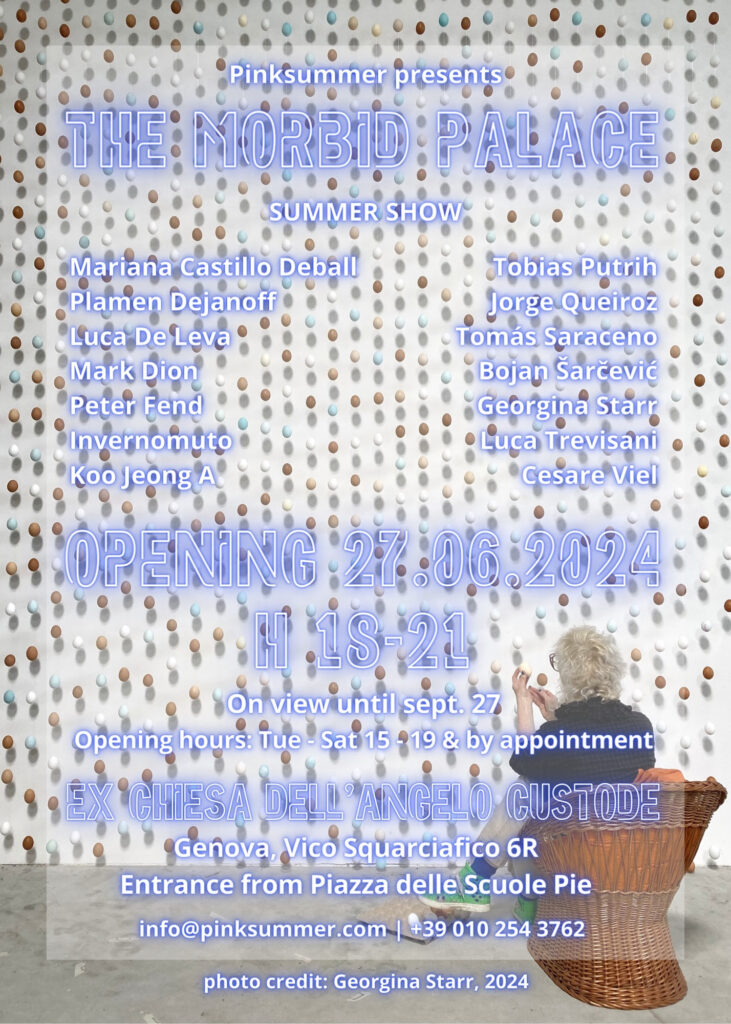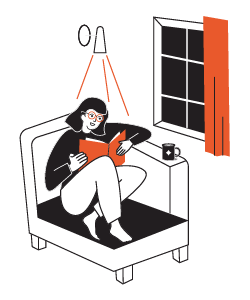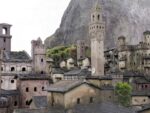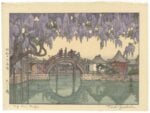The morbid palace

La mostra estiva di Pinksummer.
Comunicato stampa
“We are a blaze in the northern sky” cantavano i Darkthrone negli anni Novanta.
Si potrebbe però aggiungere con Eugene Thacker che il luogo dell’orrore, quel genere di orrore metafisico che si attua dentro una prospettiva materialistica e schiettamente laica, rende il pianeta un posto magico.
Questa premessa per introdurre una collettiva estiva di Pinksummer dal titolo The Morbid Palace, il Palazzo Morboso, titolo anche suggerito dal luogo in cui si terrà la mostra, che non sarà la galleria, ma uno spazio rimasto segreto e abbandonato e in qualche modo protetto dalle logiche asfissianti del tardo capitalismo. La stanza assai curiosa e imponente è dentro a un palazzo del XIII secolo, nel centro della città, vicinissimo alla cattedrale di San Lorenzo: abbiamo saputo della sua esistenza grazie all’amico architetto Valter Scelsi. Per secoli chiesa dell’Angelo Custode di Vico Squarciafico, dall’inizio del XX secolo fino al secondo dopoguerra è stata invece una centrale elettrica e infine è stata dimenticata fino a questa nostra mostra. Ringraziamo qui i nuovi proprietari che hanno appena acquisito l’immobile per aver acconsentito a prestarci questo luogo speciale e ad aprirlo al pubblico dopo settant’anni con la mostra The Morbid Palace.
La mostra, essendo una collettiva di galleria - seppur verranno presentate anche opere nuove prodotte per l’occasione e una performance inaugurale di Georgina Starr, con in seguito una seconda performance di Luca De Leva - non meriterebbe forse elucubrazioni tipiche da comunicato stampa, ma per noi le collettive, rare in verità, sono un’occasione per intravvedere, negli artisti che rappresentiamo, ciò che ci piace tanto e che vorremmo venisse fuori nella mostra. Vale a dire quell’attitudine tipica che li accomuna “al di là del bel canto”, che pur muovendo tutti da una prospettiva pessimista, non la risolvono mai in una contemplazione intimista chiusa nei propri affetti, ma si trasforma piuttosto in stimolo, impulso di vita attiva e combattiva del presente, impegnata. L’attitudine per noi, un po’ romantiche, potrebbe essere riassunta in quella lettera che Lovecraft scrisse nel 1935 a Catherine L. Moore “Se vuole essere arte autentica deve raffigurare in primis la cristallizzazione e la simbolizzazione di una precisa disposizione d’animo umano, non la delineazione degli eventi”. Sì, l’opera deve restituire un’atmosfera rispetto a “quell’infruttuosa aspirazione umana”, come direbbe Shopenhauer, che rende la contemplazione estetica il farmaco che ci rigenera, fuori dall’illusione, dalla paura che diventa ansia, così comune nei tempi che incombono, in cui l’uomo per la prima volta ha a che fare oltre che con la sua inadeguatezza ontologica, con il fatto certo che l’Antropocene non prevede soluzioni eroiche.
L'approccio squisitamente anti-umanistico di The Morbid Palace è solo per contrastare la hybris del genere umano nella Storia, con Leopardi la mostra potrebbe enunciare “L’uomo è solo una menomissima parte dell’universo”; tuttavia l’angoscia si trasforma nello stimolo per un nuovo umanesimo: solo quando l’uomo avrà acquisito, fatta propria, la convinzione che non rappresentiamo che un piccolo insignificante aspetto dell’immensa vita della materia universale, troveremo la forza per superare gli odi, le divisioni e trovare una nuova fraternità universale, una civiltà basata non sulla lotta, ma sulla solidarietà rispetto a un rapporto, mediato dalla coscienza (errore evolutivo?), uomo-natura impari che condividiamo con tutti gli esseri. Le differenti personalità che compongono The Morbid Palace sembrano ambire a questa nuova civiltà e la mostra appare, di fatto, come un’elegia alla fragilità.
In mostra ci saranno opere, in ordine alfabetico, di:
Mariana Castillo Deball, Plamen Dejanoff, Luca De Leva, Mark Dion, Peter Fend, Invernomuto, Koo Jeong A, Tobias Putrih, Jorge Queiroz, Tomás Saraceno, Bojan Šarčević, Georgina Starr, Luca Trevisani, Cesare Viel.
"We are a blaze in the northern sky" Darkthrone used to sing in the 1990s.
However, we might add in the words of Eugene Thacker that the place of horror, the kind of metaphysical horror that takes place within a materialistic and overtly secular perspective, makes the planet a magical place.
This premise introduces a summer group show by Pinksummer entitled The Morbid Palace, a title also suggested by the place where the exhibition will take place, which will not be the gallery, but a space that has remained secret and abandoned and somehow protected from the asphyxiating logic of late capitalism. The very curious and imposing room is inside a 13th-century building in the city centre, very close to the Cathedral of San Lorenzo: we learned about its existence thanks to our architect friend Valter Scelsi. For centuries the church of the Guardian Angel in Vico Squarciafico, from the beginning of the 20th century until after the Second World War it was instead a power station and was finally forgotten until our exhibition. We thank here the new owners who have just acquired the building for agreeing to lend us this special place and to open it to the public after seventy years with the exhibition The Morbid Palace.
The exhibition, as a gallery group show - although there will also be new works produced for the occasion and an inaugural performance by Georgina Starr, followed by a second performance by Luca De Leva - would perhaps not merit typical press release lucubrations, but for us group shows, rare indeed, are an opportunity to glimpse, in the artists we represent, what we like so much and would like to see in the exhibition. That is to say, that typical attitude that unites them "beyond the belcanto", that although they all move from a pessimistic perspective, they never resolve it into an intimist contemplation closed within their own affections, but rather it is transformed into a stimulus, an impulse for an active and combative life of the present, a committed one. The attitude for us, somewhat romantically inclined, could be summed up in that letter Lovecraft wrote in 1935 to Catherine L. Moore: 'If it is to be authentic art, it must primarily depict the crystallisation and symbolisation of a precise human mood, not the delineation of events'.
Yes, the work must restore an atmosphere with respect to "that fruitless human aspiration", as Shopenhauer would say, that makes aesthetic contemplation the drug that regenerates us, out of the illusion, out of the fear that becomes anxiety, so common in the impending times, in which man for the first time has to deal not only with his ontological inadequacy, but also with the certain fact that the Anthropocene does not provide for heroic solutions.
The exquisitely anti-humanistic approach of The Morbid Palace is only to counter the hybris of mankind in History, with Leopardi the exhibition could enunciate 'Man is only a very small part of the universe'; however, the anguish is transformed into the stimulus for a new humanism: only when man has acquired, made his own, the conviction that we represent no more than a tiny insignificant aspect of the immense life of universal matter, will we find the strength to overcome hatreds, divisions and find a new universal brotherhood, a civilisation based not on struggle, but on solidarity with respect to a relationship, mediated by consciousness (evolutionary error? ), unequal man-nature relationship that we share with all beings. The different personalities that make up The Morbid Palace seem to aspire to this new civilisation and the exhibition appears, in fact, as an elegy to fragility.
The exhibition will show artworks, in alphabetical order, by:
Mariana Castillo Deball, Plamen Dejanoff, Luca De Leva, Mark Dion, Peter Fend, Invernomuto, Koo Jeong A, Tobias Putrih, Jorge Queiroz, Tomás Saraceno, Bojan Šarčević, Georgina Starr, Luca Trevisani, Cesare Viel.



